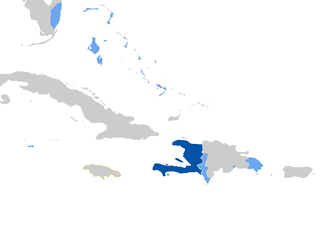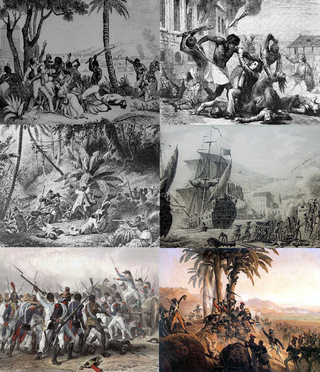
The Dominican Republic is a North American country located on the island of Hispaniola in the Greater Antilles of the Caribbean Sea in the North Atlantic Ocean. It shares a maritime border with Puerto Rico to the east and a land border with Haiti to the west, occupying the eastern five-eighths of Hispaniola which, along with Saint Martin, is one of only two islands in the Caribbean shared by two sovereign states. In the Antilles, the country is the second-largest nation by area after Cuba at 48,671 square kilometers (18,792 sq mi) and second-largest by population after Haiti with approximately 11.4 million people in 2024, of whom 3.6 million reside in the metropolitan area of Santo Domingo, the capital city.

Haiti, officially the Republic of Haiti, is a country on the island of Hispaniola in the Caribbean Sea, east of Cuba and Jamaica, and south of The Bahamas. It occupies the western three-eighths of the island, which it shares with the Dominican Republic. Haiti is the third largest country in the Caribbean, and with an estimated population of 11.4 million, is the most populous Caribbean country. The capital and largest city is Port-au-Prince.

Hispaniola is an island between Cuba and Puerto Rico in the Greater Antilles of the Caribbean. Hispaniola is the most populous island in the West Indies, and the second-largest by land area, after Cuba. The 76,192-square-kilometre (29,418 sq mi) island is divided into two separate sovereign countries: the Spanish-speaking Dominican Republic (48,445 km2 to the east and the French and Haitian Creole–speaking Haiti (27,750 km2 to the west. The only other divided island in the Caribbean is Saint Martin, which is shared between France and the Netherlands.

Port-au-Prince is the capital and most populous city of Haiti. The city's population was estimated at 1,200,000 in 2022 with the metropolitan area estimated at a population of 2,618,894. The metropolitan area is defined by the IHSI as including the communes of Port-au-Prince, Delmas, Cité Soleil, Tabarre, Carrefour, and Pétion-Ville.

Nel Ust Wyclef Jean is a Haitian rapper and record producer. At the age of nine, he emigrated with his family to the Northeastern United States. In 1990, he formed the New Jersey–based hip hop trio Fugees with fellow musicians Lauryn Hill and Pras Michel. Jean served as lead guitarist and producer. The group released the albums Blunted on Reality (1994) and The Score (1996), the latter becoming one of the best-selling albums of all time. Following their success, Jean released his debut solo album, Wyclef Jean Presents The Carnival (1997), which yielded the Billboard Hot 100-top ten single "Gone till November".

Haitian Creole, or simply Creole, is a French-based creole language spoken by 10 to 12 million people worldwide, and is one of the two official languages of Haiti, where it is the native language of the vast majority of the population. Northern, Central, and Southern dialects are the three main dialects of Haitian Creole. The Northern dialect is predominantly spoken in Cap-Haïtien, Central is spoken in Port-au-Prince, and Southern in the Cayes area.

The United States occupation of Haiti began on July 28, 1915, when 330 U.S. Marines landed at Port-au-Prince, Haiti, after the National City Bank of New York convinced the President of the United States, Woodrow Wilson, to take control of Haiti's political and financial interests. The July 1915 occupation took place following years of socioeconomic instability within Haiti that culminated with the lynching of President of Haiti Vilbrun Guillaume Sam by a mob angered by his decision to order the executions of political prisoners.

The Haitian Revolution was a successful insurrection by self-liberated slaves against French colonial rule in Saint-Domingue, now the sovereign state of Haiti. The revolution was the only known slave uprising in human history that led to the founding of a state which was both free from slavery and ruled by non-whites and former captives.

The Haiti national football team represents Haiti in international football. Haiti is administered by the Fédération Haïtienne de Football (FHF), the governing body for football in Haiti. They have been a member of FIFA since 1934, a member of CONCACAF since 1961 and a member of the Caribbean Football Union (CFU) since 1978. Haiti's home ground is Stade Sylvio Cator in Port-au-Prince and the team's manager is Gabriel Calderón Pellegrino.

Haitian Vodou is an African diasporic religion that developed in Haiti between the 16th and 19th centuries. It arose through a process of syncretism between several traditional religions of West and Central Africa and Roman Catholicism. There is no central authority in control of the religion and much diversity exists among practitioners, who are known as Vodouists, Vodouisants, or Serviteurs.
Miquel Robusté Colomer is a Spanish footballer who plays for UE Vilassar de Mar as a central defender.
Reaper is the electro-industrial project of Vasi Vallis.

Robuste was an 80-gun Bucentaure-class 80-gun ship of the line of the French Navy, designed by Jacques-Noël Sané.

The 2010 Haiti earthquake was a catastrophic magnitude 7.0 Mw earthquake that struck Haiti at 16:53 local time on Tuesday, 12 January 2010. The epicenter was near the town of Léogâne, Ouest department, approximately 25 kilometres (16 mi) west of Port-au-Prince, Haiti's capital.

François-André Baudin was a French Navy officer and nobleman. His nephew Auguste Baudin also served as an officer in the French navy.
The French corvette Robuste was a vessel built at Nantes in 1789 as a slaver that made her first and only slave-trading voyage in 1789-90. The French navy purchased her in December 1793 and she served as a 22-gun corvette in the Channel. The British captured her in 1796 and took her into the Royal Navy as HMS Scourge. She captured a number of French privateers, primarily in the West Indies, before the navy sold her in 1802.
War in Peace is a 1925 German silent film directed by Carl Boese and starring Trude Berliner, Hans Sternberg, and Charles Willy Kayser.
Thirteen ships of the French Navy have borne the name Robuste ("Robust"):

Robuste was an 74-gun ship of the line of the French Navy, built by Antoine Groignard.

The Battle of Maguelone was a naval engagement which occurred on 25 October 1809 during the Peninsular War between a French Imperial Navy squadron of three ships of the line and two frigates and a six-ship squadron of the British Royal Navy. In a running battle, the French squadron covered the retreat of a convoy they were escorting and attempted to escape from the British by sailing in shallow waters close to the shore of Villeneuve-lès-Maguelone. After two French ships of the line ran aground, their crews evacuated and scuttled them after removing valuable equipment, including the cannons onboard. The remaining ships of the French squadron then escaped to Toulon. A British cutting out party subsequently attacked the convoy off Roses, Girona on 1 November, destroying most of it and capturing three ships.













